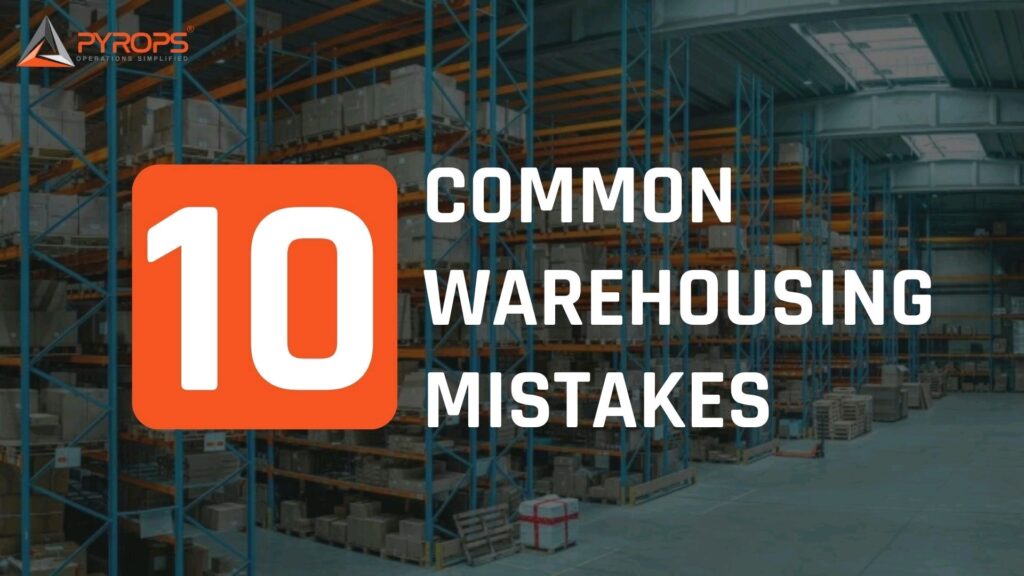Managing warehouses has become increasingly intricate due to supply chain bottlenecks and a surge in online sales, compounded by heightened expectations for rapid shipping. The evolving landscape places significant pressure on warehouses to deliver optimal performance. Regardless of size or experience, many companies encounter challenges in the warehouse management system. Efficient warehousing is pivotal in logistics, encompassing inventory storage, packaging, and product distribution. Leveraging comprehensive warehousing solutions is imperative for seamless operations, ensuring customer satisfaction and the smooth flow of business processes. Here are the top ten warehousing mistakes made by organizations and steps to be taken to avoid them: –
Inaccurate Inventory Management
- The most important responsibility in warehouse management is inventory accuracy. Inaccurate inventory numbers lead to several issues like operational confusion, unfulfilled orders, need for inventory audits, failed customer SLAs, increased time for finding products in the warehouse and many more.
- Today’s warehouses should have a robust warehouse management system (WMS) that integrates things like inventory management and tracking, order fulfilment, shipping, receiving, reverse logistics, and more. These systems can even integrate with other technology solutions, like mobile carts, wireless headsets, and automated shelving or conveyors.
Wrong KPIs
- Measuring KPIs such as average time for order picking or the number of time products spends on the shelves is great, but if the whole picture is missing – from receiving through shipping – it will be difficult to notice the inefficiencies and expenses that could be avoided.
- Understanding the critical metrics for business operations is the initial step in gathering actionable data within a warehouse. To ensure effective tracking of these metrics, implementing top warehouse management systems is crucial. Once these systems are in place, collecting and analyzing data becomes a straightforward process.
- If unsure about the specific information to collect for warehouse operations, consider engaging a warehouse optimization specialist or logistics consultant well-versed in top warehouse management systems. Investing in their expertise can streamline the process of determining what should be tracked, leading to the establishment of efficient processes and KPIs for continuous monitoring.
Poor layout
- It is imperative to design the facility layout carefully to prevent non-essential movement. Involving a warehousing layout expert to design a facility with a smoother flow helps in accurately positioning & setting up different areas. When warehouse space is at a premium, it can seem a luxury to designate separate areas for shipping out orders and receiving goods. However, not separating these areas at least in some way can lead to inefficiencies and mistakes that cost money.
- During peak activity, mistakes like placing just-received products directly onto outbound trucks or returning a packed order to shelves can cause significant delays and inefficiencies. These errors severely impact customer satisfaction and lead to wastage. Implementing the best warehouse system and employing effective warehouse management solutions is crucial to prevent such occurrences and maintain seamless operations.
- Consider placing shipping and receiving in completely different bays of the warehouse so there is little chance for confusion. Proper planning of different types of storage areas and operating areas with physical and visual demarcation tremendously helps in enabling a seamless operational flow
Failure to optimize Picking path
- Another common mistake organizations make is poor optimization of order picking paths in the warehouse. Picking costs are a significant contributor to warehousing costs. Inefficient pick planning directly impacts unit economics and profitability. Besides, optimizing picking effort helps boost employee productivity and morale.
- To make the best use of their time and energy, one should carefully study the location of the items about one’s pick speed. Often picking products must place in close vicinity to each other as much as possible. Achieving this type of analysis is much more complicated, but with the right software packages, one can resolve this challenge.
Sticking to paper-based processes
- There’s no justification for warehouses to rely on paper-based workflows when numerous options in the digital realm can optimize documentation processes. Employing paper for every task raises the risk of errors and lost paperwork, demanding additional person-hours for management and causing unnecessary cost escalations. Embracing top WMS (Warehouse Management Systems) ensures streamlined and efficient documentation processes, reducing the likelihood of mistakes and enhancing overall operational efficiency.
- Embracing the technology that is available by installing effective software to manage data and inventory will help gain better visibility, so it can be known exactly where the products are at all times, how many are in stock, the stock levels and when is there a need to restock or filter out an obsolete item. Switching even portions of operations over to digital processes can increase efficiency and accuracy, leading to an overall decrease in costs over time.
Holding excess Inventory
- Having too much inventory on hand can be costly in many ways. Firstly, it takes up storage space that could be used for other products. In addition to this, excess inventory can delay other processes such as picking, restocking, etc. Items that sit at the back of the warehouse can become obsolete and forgotten, preventing organizations from making profits off those items. Reducing the levels of inventory as much as possible can lead to a leaner supply chain without losses. Utilizing software packages and receiving large orders in smaller batches are both ways to accomplish this. This helps to maintain optimum inventory levels.
Lack of Safety Policies
- Even an organized warehouse isn’t always safe. If employees are constantly injured, they will need to spend more time off work or will work slowly to prevent their injuries from getting worse. Lack of safety policies can have serious consequences. It can lead to injuries, which will invite workforce-related issues. Apart from injuries, working in an unsafe manner can slow down your process and increase labour costs.
- It is important to maintain strict safety policies. This ensures employees are not cutting corners and following ergonomic practices. Rules & directives have to be made to ensure strict adherence to such policies
Lack of proper training & workforce development
- Another big challenge in warehousing is employee turnover. When a worker leaves an organization, a significant cost comes along with it. Employees leave for various reasons, but one common reason is that they do not believe they are receiving the right amount of training and development opportunities to exceed expectations and grow.
- Employees that do not receive training and development opportunities makes them more prone to mistakes, thereby reducing quality and increasing inefficiency in the supply chain. Sending employees onto the warehouse floor without training on proper work procedures and safety is a recipe for disaster
- Investing in training can not only reduce workplace injuries but also improve productivity and efficiency. At the same time, proper training lets workers know that they care about their well-being. This can improve employee retention rates.
Improper housekeeping
- Warehouse cleanliness or tidiness is one of its top priorities. Shelves dust layers, aisles debris, and equipment broken pieces are all apparent signs of a dirty warehouse. Messy warehouses are not just hazardous, but they also obstruct the flow of goods and people, reducing productivity.
- The remedy is to make cleanliness as one of the standards. Every employee shift should have a cleaning schedule with checklists and deep cleaning of the facility should take place periodically. Establishing a housekeeping routine by regularly tidying up and cleaning after every shift can help drastically. This will allow the next shift to be more productive as they begin working in an organized and clean environment. Warehouses can also follow the 5S principle to make them highly organized, and efficient and increase productivity.
Failure to be future ready
- What works now may not work in the future, especially if operations grow. If the company is not constantly growing and evolving, it will eventually fall on its face. Managing the growth rates is different depending on the industry and company. But the future growth plans of the company are essential.
- Not taking the time and effort to plan for that potential someday can cost a lot in the end. If the warehouse is not keeping up with the latest changes in the industry, or it is not evaluating the processes to minimize the inefficiencies, the business will suffer.
- Scheduling weekly, quarterly or monthly reviews of the progress toward these goals. This will help in quickly adapting or correcting the course. Taking the time to plan for the future allows the warehouse to see opportunities and jump on them as they come up. This will avoid a sudden panic period when it needs to adapt and change the business operations owing to various market dynamics, growth strategies or forces majeure.
Effective Warehouse Solutions For Operations
The 10 common warehousing mistakes mentioned above show that managing operations is a complex task. Success depends on paying attention to people, processes, and the warehouse management. Avoiding these mistakes helps build a strong foundation for ongoing improvements. This proactive approach lets you focus on getting better instead of spending too much time dealing with urgent issues.
Pyrops WMS provides better warehousing soultions to optimize processes, enhance productivity, and provide a solid foundation for continuous improvement. Elevate your warehouse management to new heights with our innovative technology. Contact us today to embark on a journey towards a smarter, more efficient warehouse







